Electrophysiological Correlation Underlying the Effects of Music Preference on the Prefrontal Cortex Using a Brain–Computer Interface
Abstract
1. Introduction
2. Materials
2.1. EEG Acquisition Module
2.2. Stimuli
3. Methods
3.1. Subjects
3.2. Experimental Design
3.3. EEG Recordings, Data Processing, and Statistical Analysis
4. Results
4.1. Preference Ratings and Subjective Evaluation of the Cognitive State
4.2. Statistical Analysis for EEG Waves
5. Discussion
5.1. Behavioural Rating
5.2. Theta Power and Alpha Power
5.3. Lower Alpha, Upper Alpha, and Beta Power
6. Conclusions
Funding
Institutional Review Board Statement
Informed Consent Statement
Data Availability Statement
Acknowledgments
Conflicts of Interest
References
- Eerola, T.; Vuoskoski, J.K. A comparison of the discrete and dimensional models of emotion in music. Psychol. Music 2011, 39, 18–49. [Google Scholar] [CrossRef]
- Liu, Y.; Tang, Q.; Zhao, X.; Lu, H.; Yuan, G.; Wang, G.; Liu, G. Neural activation of different music styles during emotion-evoking. Psychol. Music 2020, 12, 1–15. [Google Scholar] [CrossRef]
- Tsang, C.; Trainor, L.; Santesso, D.; Tasker, S.; Schmidt, L. Frontal EEG responses as a function of affective musical features. Ann. N. Y. Acad. Sci. 2001, 930, 439–442. [Google Scholar] [CrossRef]
- Hohmann, L.; Bradt, J.; Stegemann, T.; Koelsch, S. Effects of music therapy and music-based interventions in the treatment of substance use disorders: A systematic review. PLoS ONE 2017, 12, e0187363. [Google Scholar] [CrossRef] [PubMed]
- Sihvonen, A.J.; Särkämö, T.; Leo, V.; Tervaniemi, M.; Altenmüller, E.; Soinila, S. Music-based interventions in neurological rehabilitation. Lancet Neurol. 2017, 16, 648–660. [Google Scholar] [CrossRef]
- Cassidy, G.; MacDonald, R.A.R. The effect of background music and background noise on the task performance of introverts and extraverts. Psychol. Music 2007, 35, 517–537. [Google Scholar] [CrossRef]
- Gola, M.; Kamiński, J.; Brzezicka, A.; Wróbel, A. Beta band oscillations as a correlate of alertness—Changes in aging. Int. J. Psychophysiol. 2012, 85, 62–67. [Google Scholar] [CrossRef]
- Scaringella, N.; Zoia, G.; Mlynek, D. Automatic genre classification of music content: A survey. IEEE Signal Proc. Mag. 2006, 23, 133–141. [Google Scholar] [CrossRef]
- Levitin, D.J.; Grahn, J.A.; London, J. The psychology of music: Rhythm and movement. Ann. Rev. Psychol. 2018, 69, 51–75. [Google Scholar] [CrossRef]
- Cassidy, G.; Macdonald, R. The effects of music choice on task performance: A study of the impact of self-selected and experimenter-selected music on driving game performance and experience. Musicae Sci. 2009, 13, 357–386. [Google Scholar] [CrossRef]
- Heilman, K.M. The neurobiology of emotional experience. J. Neurop. Clin. Neurosci. 1997, 9, 439–448. [Google Scholar]
- Geringer, J.M.; Madsen, C.K.; Gregory, D. A fifteen-year history of the continuous response digital interface: Issues relating to validity and reliability. Bull. Counc. Res. Music Educ. 2004, 160, 1–15. [Google Scholar]
- Brittin, R.V. Listeners’ Preference for Music of Other Cultures: Comparing Response Modes. J. Res. Music Educ. 1996, 44, 328–340. [Google Scholar] [CrossRef]
- Williams, L.R.; Fredrickson, W.E.; Atkinson, S. Focus of attention to melody or harmony and perception of music tension: An exploratory study. Int. J. Music Educ. 2011, 29, 72–81. [Google Scholar] [CrossRef]
- Wagner, V.; Scharinger, M.; Knoop, C.A.; Menninghaus, W. Effects of continuous self-reporting on aesthetic evaluation and emotional responses. Poetics 2020, 101497. [Google Scholar] [CrossRef]
- Lin, L.-C.; Ouyang, C.-S.; Chiang, C.-T.; Wu, R.-C.; Wu, H.-C.; Yang, R.-C. Listening to Mozart K.448 decreases electroencephalography oscillatory power associated with an increase in sympathetic tone in adults: A post-intervention study. JRSM Open 2014, 5, 2054270414551657. [Google Scholar] [CrossRef] [PubMed]
- Gupta, A.; Bhushan, B.; Behera, L. Short-term enhancement of cognitive functions and music: A three-channel model. Sci. Rep. 2018, 8, 15528. [Google Scholar] [CrossRef] [PubMed]
- Abhang, P.A.; Gawali, B.W.; Mehrotra, S.C. Technical Aspects of Brain Rhythms and Speech Parameters. In Introduction to EEG- and Speech-Based Emotion Recognition; Abhang, P.A., Gawali, B.W., Mehrotra, S.C., Eds.; Academic Press: Cambridge, MA, USA, 2016; pp. 51–79. [Google Scholar]
- Sammler, D.; Grigutsch, M.; Fritz, T.; Koelsch, S. Music and emotion: Electrophysiological correlates of the processing of pleasant and unpleasant music. Psychophysiology 2007, 44, 293–304. [Google Scholar] [CrossRef]
- Sheldon, S.; Donahue, J. More than a feeling: Emotional cues impact the access and experience of autobiographical memories. Memory Cognit. 2017, 45, 731–744. [Google Scholar] [CrossRef] [PubMed]
- Quandt, L.C.; Marshall, P.J.; Shipley, T.F.; Beilock, S.L.; Goldin-Meadow, S. Sensitivity of alpha and beta oscillations to sensorimotor characteristics of action: An EEG study of action production and gesture observation. Neuropsychologia 2012, 50, 2745–2751. [Google Scholar] [CrossRef]
- Lemus, L.; Hernández, A.; Luna, R.; Zainos, A.; Romo, R. Do sensory cortices process more than one sensory modality during perceptual judgments? Neuron 2010, 67, 335–348. [Google Scholar] [CrossRef] [PubMed]
- Leite, J.A.A.; dos Santos, M.A.C.; da Silva, R.M.C.; Andrade, A.d.O.; da Silva, G.M.; Bazan, R.; de Souza, L.A.P.S.; Luvizutto, G.J. Alpha and beta cortical activity during guitar playing: Task complexity and audiovisual stimulus analysis. Somatosens. Motor Res. 2020, 37, 245–251. [Google Scholar] [CrossRef] [PubMed]
- Avila, C.; Furnham, A.; McClelland, A. The influence of distracting familiar vocal music on cognitive performance of introverts and extraverts. Psychol. Music 2012, 40, 84–93. [Google Scholar] [CrossRef]
- Aftanas, L.; Golocheikine, S. Human anterior and frontal midline theta and lower alpha reflect emotionally positive state and internalized attention: High-resolution EEG investigation of meditation. Neurosci. Lett. 2001, 310, 57–60. [Google Scholar] [CrossRef]
- Segrave, R.A.; Cooper, N.R.; Thomson, R.H.; Croft, R.J.; Sheppard, D.M.; Fitzgerald, P.B. Individualized alpha activity and frontal asymmetry in major depression. Clin. EEG Neurosci. 2011, 42, 45–52. [Google Scholar] [CrossRef] [PubMed]
- Hagemann, D. Individual differences in anterior EEG asymmetry: Methodological problems and solutions. Biol. Psychol. 2004, 67, 157–182. [Google Scholar] [CrossRef] [PubMed]
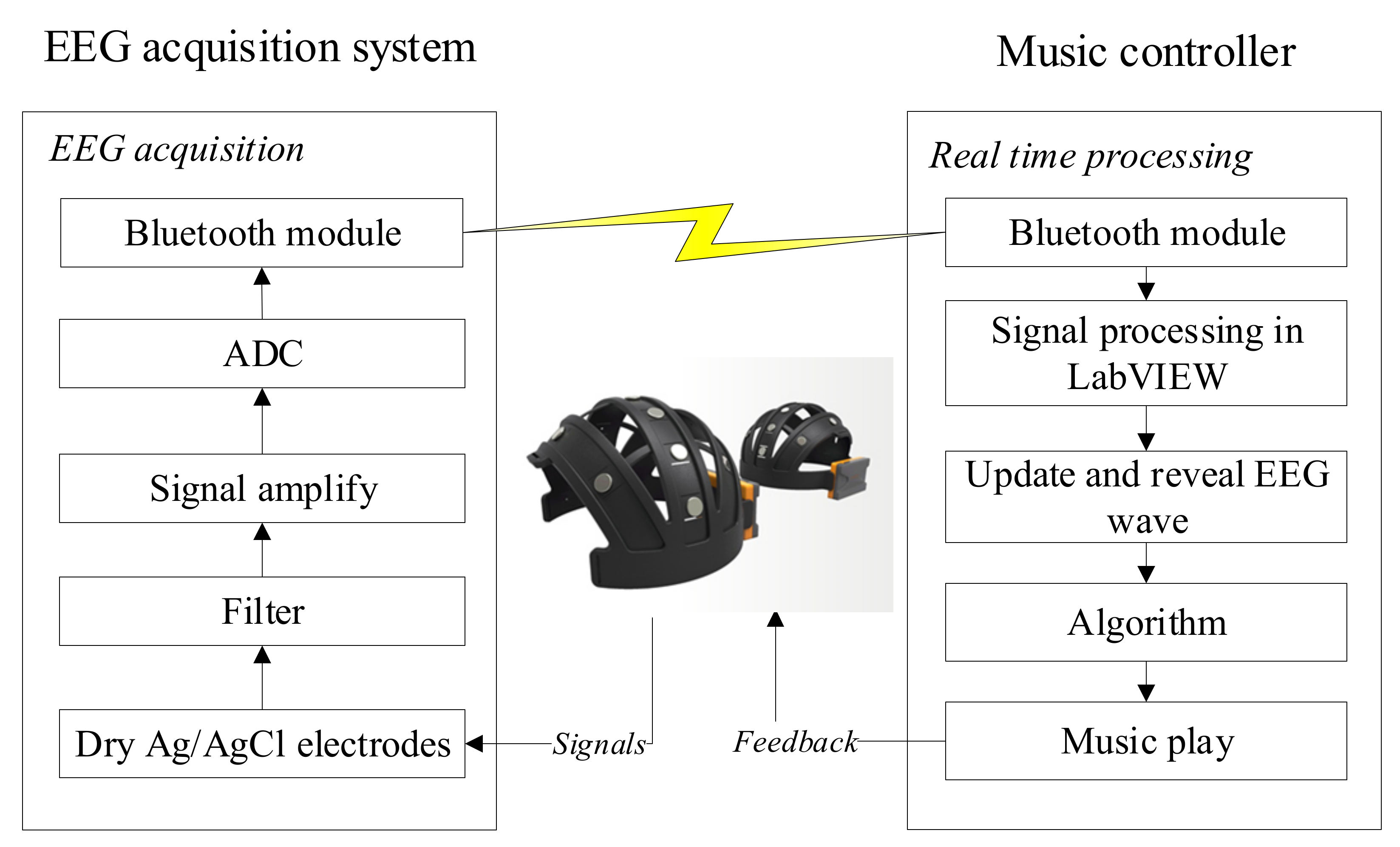
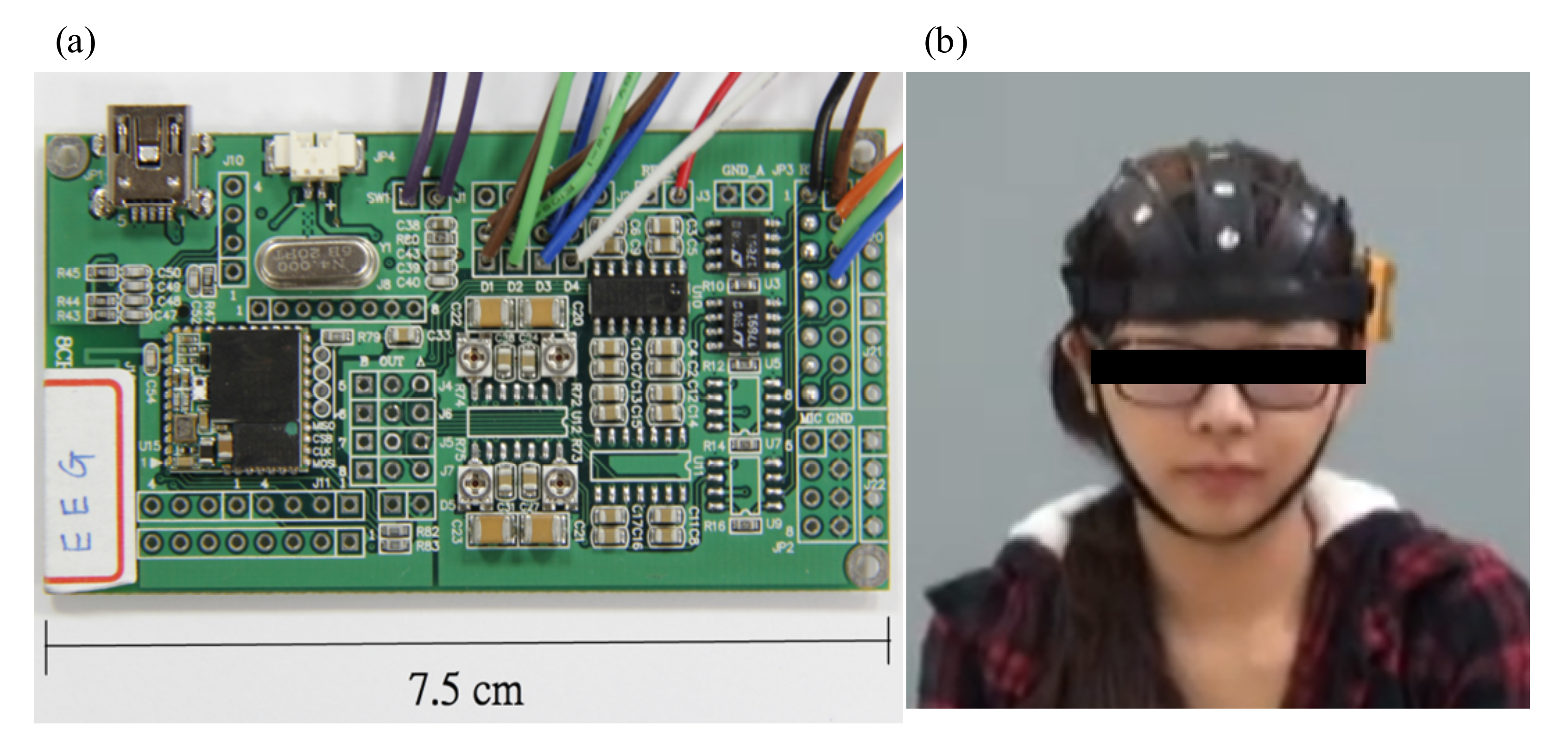
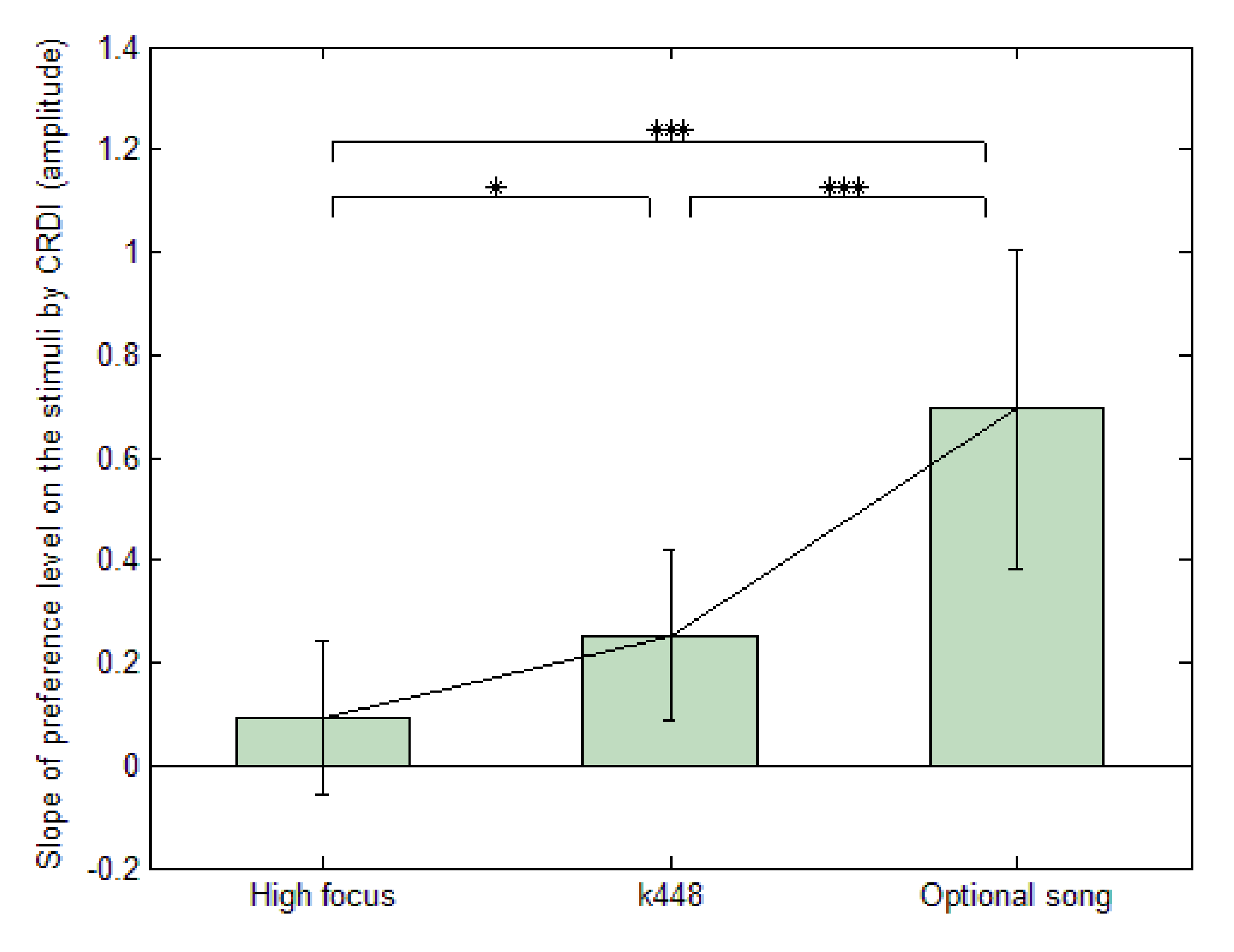
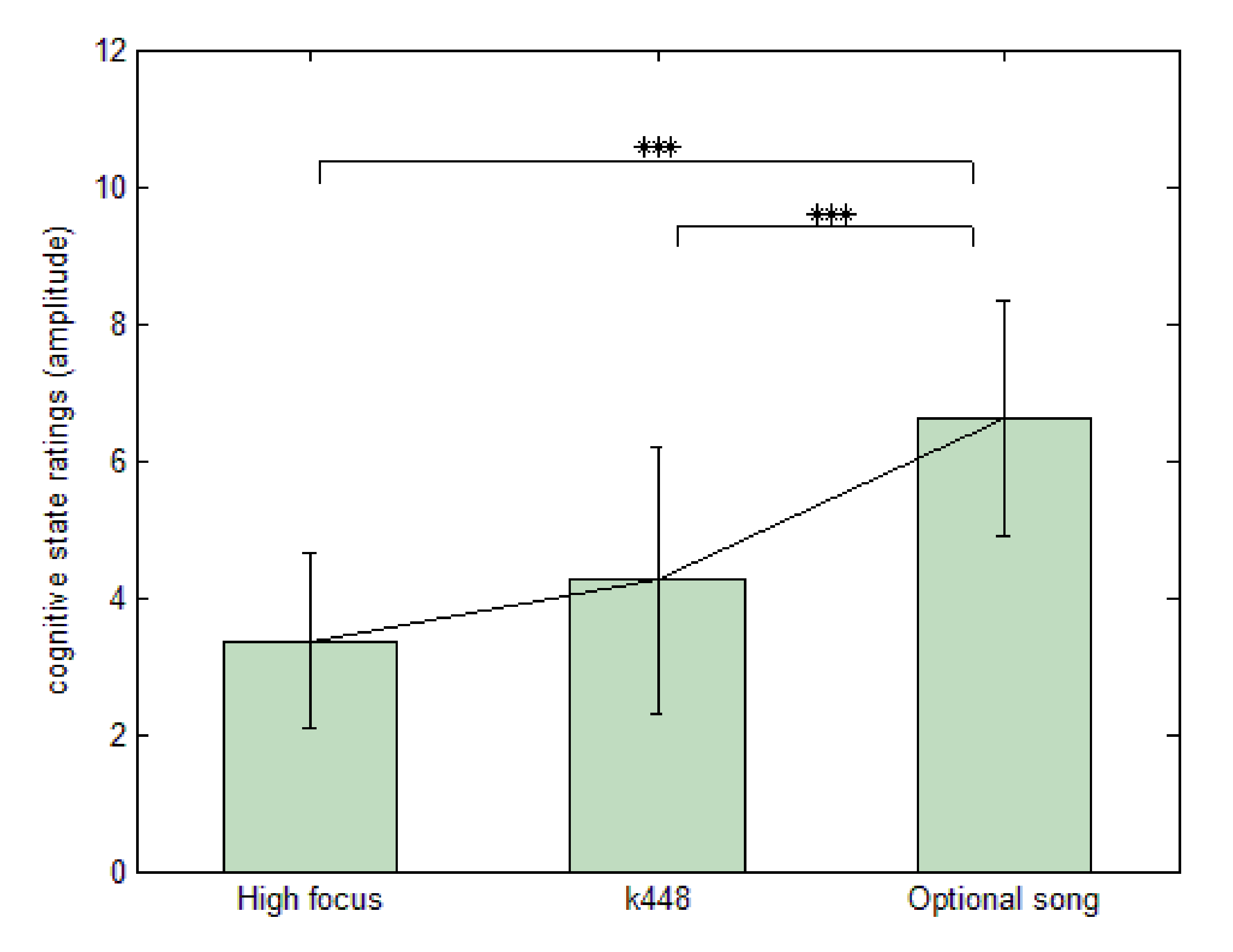
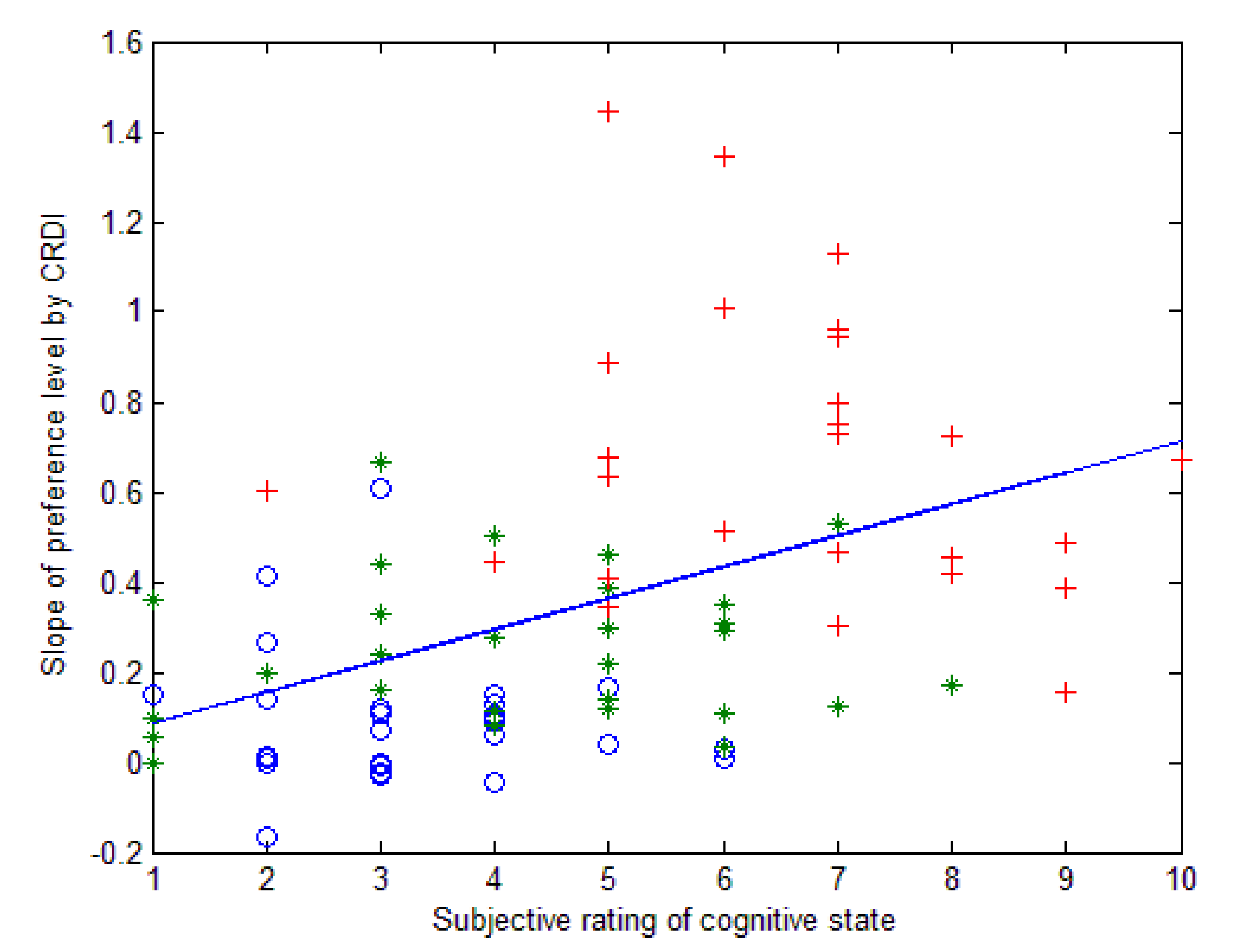
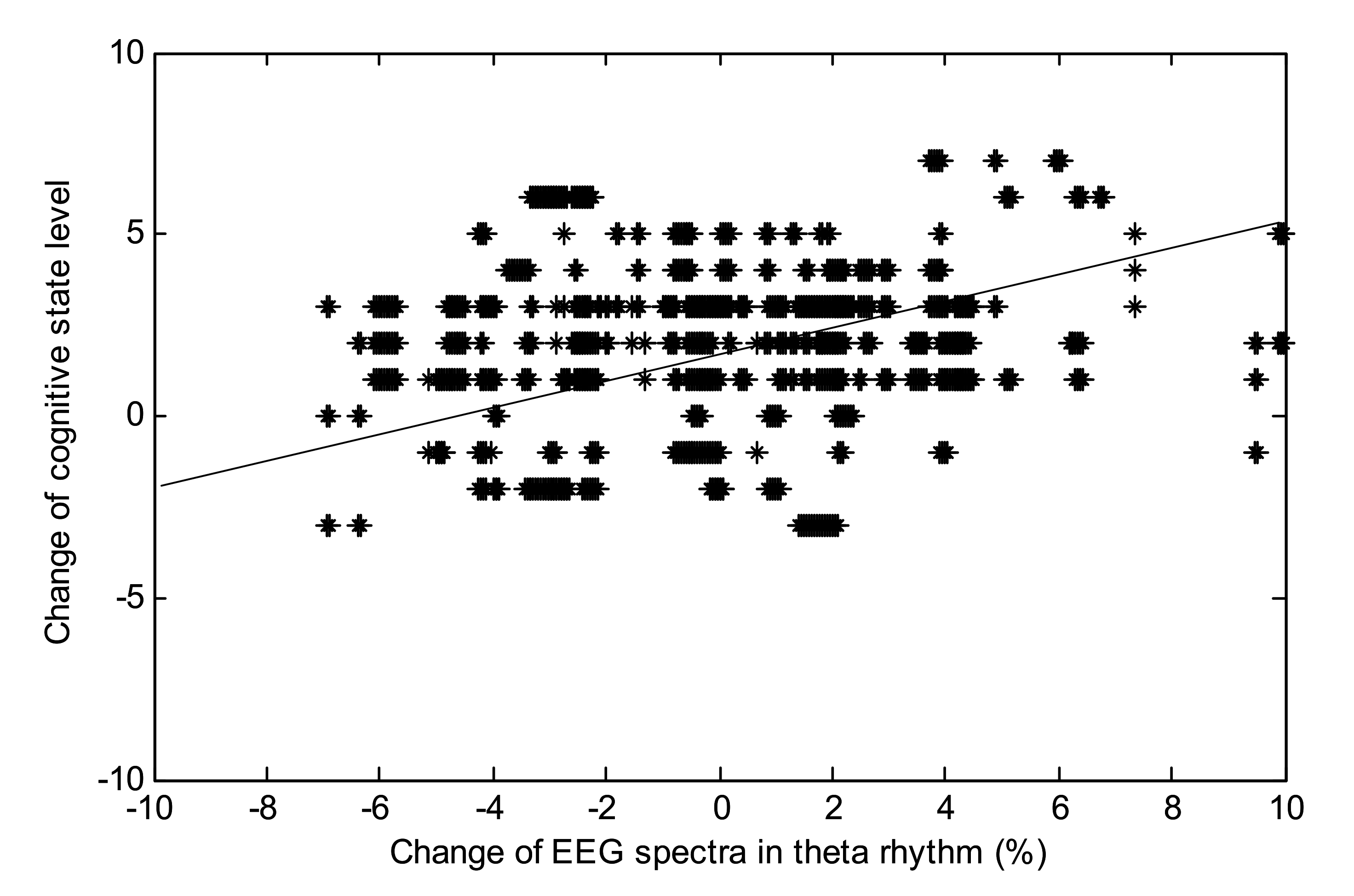
| Factor(s) | Dependent Variables | F-Values | p-Values | Partial |
|---|---|---|---|---|
| Position | Theta | 0.748 | 0.474 | 0.006 |
| Alpha | 1.556 | 0.213 | 0.013 | |
| Lower alpha | 1.527 | 0.219 | 0.012 | |
| Upper alpha | 5.543 ** | 0.004 | 0.044 | |
| Beta | 5.528 ** | 0.004 | 0.044 | |
| Time | Theta | 10.739 *** | <0.001 | 0.081 |
| Alpha | 5.930 ** | 0.003 | 0.047 | |
| Lower alpha | 5.648 ** | 0.004 | 0.044 | |
| Upper alpha | 2.924 | 0.056 | 0.023 | |
| Beta | 2.910 | 0.056 | 0.023 | |
| Position × Time | Theta | 0.076 | 0.989 | 0.001 |
| Alpha | 0.101 | 0.982 | 0.002 | |
| Lower alpha | 0.102 | 0.982 | 0.002 | |
| Upper alpha | 0.075 | 0.99 | 0.001 | |
| Beta | 0.076 | 0.99 | 0.001 |
| HF | k448 | FS | ||||||||||
|---|---|---|---|---|---|---|---|---|---|---|---|---|
| Theta | Lower Alpha | Upper Alpha | Beta | Theta | Lower Alpha | Upper Alpha | Beta | Theta | Lower Alpha | Upper Alpha | Beta | |
| Position: Fz | ||||||||||||
| Test value | 0.01 | 0.056 | 2.517 * | 0.101 | −1.199 | −0.908 | 0.52 | −1.428 | −2.966 ** | −2.07 * | −0.435 | −2.165 * |
| p | 0.992 | 0.956 | 0.018 | 0.92 | 0.241 | 0.372 | 0.607 | 0.165 | 0.006 | 0.048 | 0.667 | 0.039 |
| Position: Fp2 | ||||||||||||
| Test value | −0.584 | −0.836 | −1.017 | −0.882 | −1.237 | −1.277 | −1.496 | −1.42 | −3.513 ** | −2.427 * | −1.928 | −1.903 |
| p | 0.564 | 0.441 | 0.318 | 0.386 | 0.227 | 0.212 | 0.146 | 0.167 | 0.002 | 0.022 | 0.064 | 0.068 |
| Position: Fp1 | ||||||||||||
| Test value | −0.319 | −0.681 | −2.246 * | −0.14 | −0.903 | −1.123 | −2.381 * | −1.141 | −3.578 ** | −3.118 ** | −3.326 ** | −1.928 |
| p | 0.752 | 0.501 | 0.033 | 0.989 | 0.375 | 0.272 | 0.025 | 0.264 | 0.001 | 0.004 | 0.003 | 0.064 |
| Positions | EEG Bands | Pearson Correlation | p-Values | ||
|---|---|---|---|---|---|
| CS | Intensity | CS | Intensity | ||
| Fz | Theta | 0.257 * | 0.227 * | 0.018 | 0.038 |
| Lower alpha | 0.204 | 0.154 | 0.063 | 0.976 | |
| Upper alpha | 0.198 | −0.003 | 0.071 | 0.163 | |
| Beta | 0.198 | −0.003 | 0.072 | 0.976 | |
| Fp2 | Theta | 0.294 ** | 0.291 ** | 0.007 | 0.007 |
| Lower alpha | 0.268 * | 0.211 | 0.014 | 0.858 | |
| Upper alpha | 0.254 * | −0.020 | 0.020 | 0.054 | |
| Beta | 0.254 * | −0.019 | 0.020 | 0.862 | |
| Fp1 | Theta | 0.271 * | 0.242 * | 0.013 | 0.027 |
| Lower alpha | 0.168 | 0.158 | 0.127 | 0.915 | |
| Upper alpha | 0.128 | 0.012 | 0.244 | 0.151 | |
| Beta | 0.127 | 0.011 | 0.251 | 0.918 | |
Publisher’s Note: MDPI stays neutral with regard to jurisdictional claims in published maps and institutional affiliations. |
© 2021 by the author. Licensee MDPI, Basel, Switzerland. This article is an open access article distributed under the terms and conditions of the Creative Commons Attribution (CC BY) license (http://creativecommons.org/licenses/by/4.0/).
Share and Cite
Tseng, K.C. Electrophysiological Correlation Underlying the Effects of Music Preference on the Prefrontal Cortex Using a Brain–Computer Interface. Sensors 2021, 21, 2161. https://doi.org/10.3390/s21062161
Tseng KC. Electrophysiological Correlation Underlying the Effects of Music Preference on the Prefrontal Cortex Using a Brain–Computer Interface. Sensors. 2021; 21(6):2161. https://doi.org/10.3390/s21062161
Chicago/Turabian StyleTseng, Kevin C. 2021. "Electrophysiological Correlation Underlying the Effects of Music Preference on the Prefrontal Cortex Using a Brain–Computer Interface" Sensors 21, no. 6: 2161. https://doi.org/10.3390/s21062161
APA StyleTseng, K. C. (2021). Electrophysiological Correlation Underlying the Effects of Music Preference on the Prefrontal Cortex Using a Brain–Computer Interface. Sensors, 21(6), 2161. https://doi.org/10.3390/s21062161






